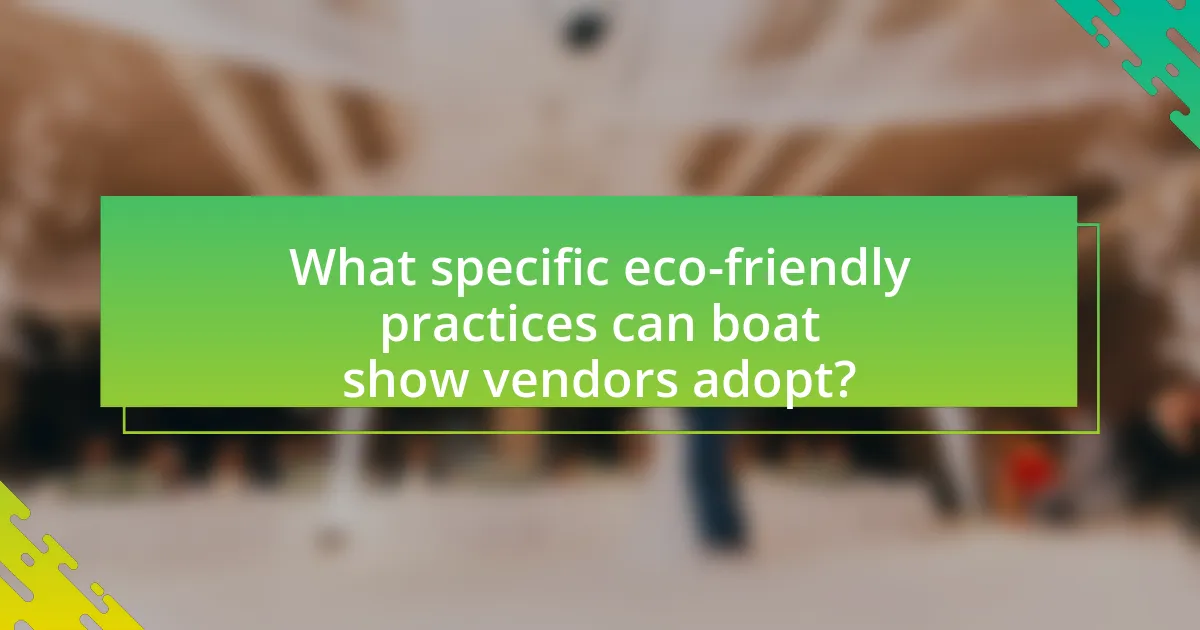Eco-friendly practices for boat show vendors focus on sustainability through the use of biodegradable materials, waste reduction, and the promotion of eco-conscious products. Vendors are encouraged to implement strategies such as recycling, composting, and energy-efficient technologies to minimize their environmental impact and align with consumer demand for sustainable practices. The article outlines the environmental challenges associated with boat shows, the benefits of adopting eco-friendly methods, and specific actions vendors can take to enhance their sustainability efforts. Additionally, it addresses common misconceptions, potential challenges, and innovative marketing strategies that can further engage customers in eco-friendly initiatives.

What are Eco-Friendly Practices for Boat Show Vendors?
Eco-friendly practices for boat show vendors include using sustainable materials, minimizing waste, and promoting eco-conscious products. Vendors can utilize biodegradable or recyclable materials for displays and packaging, which reduces environmental impact. Additionally, implementing a waste management system that encourages recycling and composting can significantly decrease landfill contributions. Promoting products that are energy-efficient or made from renewable resources further aligns with eco-friendly principles. According to the Environmental Protection Agency, reducing waste and using sustainable materials can lower the carbon footprint associated with events, making these practices not only beneficial for the environment but also appealing to increasingly eco-conscious consumers.
Why should boat show vendors adopt eco-friendly practices?
Boat show vendors should adopt eco-friendly practices to reduce environmental impact and meet growing consumer demand for sustainability. Implementing eco-friendly practices can lead to decreased waste, lower carbon footprints, and enhanced brand reputation. According to a 2021 survey by Nielsen, 73% of global consumers are willing to change their consumption habits to reduce environmental impact, indicating a strong market preference for sustainable products and practices. By aligning with these values, vendors can attract more customers and potentially increase sales while contributing positively to environmental conservation.
What environmental impacts do boat shows have?
Boat shows have several environmental impacts, primarily including pollution, habitat disruption, and resource consumption. The presence of numerous boats can lead to water pollution from fuel spills, waste discharge, and runoff from cleaning products. Additionally, the assembly of large crowds and infrastructure can disrupt local ecosystems, particularly in coastal areas where sensitive habitats may be affected. According to a study by the National Oceanic and Atmospheric Administration, recreational boating contributes significantly to water quality degradation in popular marine areas. Furthermore, boat shows often require substantial energy and materials for setup and operation, leading to increased carbon footprints.
How can eco-friendly practices mitigate these impacts?
Eco-friendly practices can mitigate environmental impacts by reducing waste, conserving resources, and minimizing pollution. For instance, implementing recycling programs at boat shows can significantly decrease the amount of plastic and other materials that end up in landfills. According to the Environmental Protection Agency, recycling and composting prevented the release of approximately 186 million metric tons of carbon dioxide equivalent into the air in 2018. Additionally, using sustainable materials for booth construction and promotional items can lower the carbon footprint associated with production and transportation. Research from the Journal of Cleaner Production indicates that adopting green supply chain practices can lead to a 20% reduction in greenhouse gas emissions. By prioritizing eco-friendly practices, boat show vendors can contribute to a healthier environment while also appealing to environmentally conscious consumers.
What are the key components of eco-friendly practices for boat show vendors?
The key components of eco-friendly practices for boat show vendors include sustainable materials, waste reduction, energy efficiency, and environmentally responsible transportation. Sustainable materials involve using products that are recyclable or made from renewable resources, which minimizes environmental impact. Waste reduction focuses on minimizing single-use plastics and promoting recycling and composting at the event. Energy efficiency can be achieved through the use of energy-efficient lighting and equipment, reducing overall energy consumption. Environmentally responsible transportation encourages vendors to use low-emission vehicles or carpooling to reduce carbon footprints. These practices collectively contribute to a more sustainable and eco-friendly boat show environment.
What sustainable materials can vendors use in their displays?
Vendors can use sustainable materials such as bamboo, recycled cardboard, and biodegradable plastics in their displays. Bamboo is a fast-growing, renewable resource that offers durability and aesthetic appeal. Recycled cardboard reduces waste and energy consumption associated with new material production. Biodegradable plastics, made from natural materials, decompose more easily than traditional plastics, minimizing environmental impact. These materials not only support eco-friendly practices but also align with growing consumer demand for sustainability in the marketplace.
How can vendors reduce waste during the event?
Vendors can reduce waste during the event by implementing strategies such as using biodegradable or compostable materials for packaging and serving food. This approach minimizes the amount of plastic waste generated, as studies indicate that single-use plastics contribute significantly to environmental pollution. Additionally, vendors can adopt a pre-order system to accurately gauge demand, thereby reducing excess food waste. Research shows that events that utilize such systems can decrease food waste by up to 30%. Furthermore, providing clear recycling and composting stations encourages attendees to dispose of waste properly, which can lead to a higher recycling rate. By integrating these practices, vendors not only contribute to sustainability but also enhance their brand image among environmentally conscious consumers.
What are the benefits of implementing eco-friendly practices?
Implementing eco-friendly practices offers significant benefits, including reduced environmental impact, cost savings, and enhanced brand reputation. By adopting sustainable methods, businesses can lower their carbon footprint, conserve resources, and minimize waste, which contributes to a healthier ecosystem. For instance, a study by the National Oceanic and Atmospheric Administration found that eco-friendly practices in marine industries can lead to a 30% reduction in waste generation. Additionally, companies that prioritize sustainability often experience increased customer loyalty, as consumers are increasingly drawn to brands that demonstrate environmental responsibility. This shift can result in higher sales and market share, reinforcing the importance of eco-friendly practices in today’s competitive landscape.
How do eco-friendly practices enhance vendor reputation?
Eco-friendly practices enhance vendor reputation by demonstrating a commitment to sustainability and social responsibility. Vendors who adopt environmentally friendly methods, such as using sustainable materials or reducing waste, attract environmentally conscious consumers, which can lead to increased customer loyalty. Research indicates that 66% of consumers are willing to pay more for sustainable brands, highlighting the market advantage for vendors who prioritize eco-friendly practices. Additionally, positive media coverage and word-of-mouth referrals often follow vendors recognized for their environmental efforts, further solidifying their reputation in the marketplace.
What cost savings can be achieved through sustainability?
Sustainability can lead to significant cost savings through reduced energy consumption, waste management efficiencies, and resource conservation. For instance, implementing energy-efficient technologies can lower utility bills by up to 30%, as reported by the U.S. Department of Energy. Additionally, adopting waste reduction strategies can decrease disposal costs, with businesses saving an average of 20% on waste management expenses when they recycle and compost. Furthermore, utilizing sustainable materials can minimize procurement costs over time, as these materials often have lower lifecycle costs. These practices not only enhance profitability but also contribute to a more sustainable operational model.

How can boat show vendors implement eco-friendly practices?
Boat show vendors can implement eco-friendly practices by utilizing sustainable materials, reducing waste, and promoting environmentally responsible products. For instance, vendors can use biodegradable or recyclable materials for displays and packaging, which minimizes environmental impact. Additionally, they can adopt digital marketing strategies to reduce paper usage, such as using QR codes for brochures instead of printed materials. According to the Environmental Protection Agency, reducing waste through recycling and composting can significantly lower the carbon footprint of events. Furthermore, vendors can collaborate with eco-conscious brands and highlight products that are energy-efficient or made from sustainable resources, thereby encouraging attendees to make environmentally friendly choices.
What steps should vendors take to become more sustainable?
Vendors should adopt eco-friendly practices such as reducing waste, sourcing sustainable materials, and implementing energy-efficient operations to become more sustainable. Reducing waste can be achieved by minimizing single-use plastics and encouraging recycling at events, which aligns with the growing consumer demand for environmentally responsible practices. Sourcing sustainable materials involves selecting products that are biodegradable or made from recycled content, which can significantly lower the environmental impact of their offerings. Implementing energy-efficient operations, such as using LED lighting and energy-efficient equipment, can reduce energy consumption and lower carbon footprints. These steps are supported by research indicating that sustainable practices can enhance brand reputation and customer loyalty, as consumers increasingly prefer businesses that prioritize environmental responsibility.
How can vendors assess their current environmental impact?
Vendors can assess their current environmental impact by conducting a comprehensive environmental audit that evaluates resource consumption, waste generation, and emissions. This audit involves measuring energy use, water consumption, and the types and amounts of materials used in operations. For instance, a study by the Environmental Protection Agency indicates that businesses can reduce their carbon footprint by 20-30% through effective resource management and waste reduction strategies. Additionally, vendors can utilize tools such as carbon footprint calculators and sustainability reporting frameworks to quantify their environmental impact accurately.
What resources are available for vendors looking to go green?
Vendors looking to go green can access a variety of resources, including government grants, sustainability certifications, and industry-specific guidelines. Government agencies often provide financial assistance and incentives for adopting eco-friendly practices, such as the Environmental Protection Agency’s (EPA) grants for small businesses. Sustainability certifications, like ISO 14001, offer frameworks for implementing effective environmental management systems. Additionally, organizations such as the Green Business Bureau provide resources and best practices tailored to specific industries, including boating. These resources help vendors reduce their environmental impact while enhancing their marketability.
What challenges might vendors face when adopting eco-friendly practices?
Vendors may face significant challenges when adopting eco-friendly practices, primarily due to increased costs and supply chain limitations. The transition to sustainable materials often requires higher initial investments, which can deter vendors from making the switch. For instance, eco-friendly materials can be 10-30% more expensive than conventional options, impacting profit margins. Additionally, vendors may struggle with sourcing reliable suppliers who provide sustainable products, as the availability of such materials can be limited in certain regions. This challenge is compounded by the need for education and training on eco-friendly practices, which can further strain resources and time.
How can vendors overcome resistance to change?
Vendors can overcome resistance to change by actively engaging stakeholders through education and demonstrating the benefits of eco-friendly practices. By providing clear, factual information about the environmental and economic advantages of adopting sustainable methods, vendors can alleviate concerns and foster acceptance. For instance, studies show that businesses implementing eco-friendly practices can reduce operational costs by up to 30%, which serves as a compelling incentive for stakeholders to embrace change. Additionally, involving stakeholders in the decision-making process can create a sense of ownership and reduce apprehension, leading to smoother transitions.
What are common misconceptions about eco-friendly practices?
Common misconceptions about eco-friendly practices include the belief that they are always more expensive, that they require significant lifestyle changes, and that they are ineffective. Many people assume that sustainable products cost more than conventional ones; however, studies show that the price gap is narrowing as demand for eco-friendly options increases. Additionally, some individuals think adopting eco-friendly practices necessitates drastic changes, but small, incremental adjustments can lead to significant environmental benefits. Lastly, there is a misconception that eco-friendly practices do not yield tangible results; research indicates that sustainable practices can effectively reduce carbon footprints and conserve resources, demonstrating their efficacy.

What specific eco-friendly practices can boat show vendors adopt?
Boat show vendors can adopt several specific eco-friendly practices, including using biodegradable materials for promotional items and packaging. This practice reduces plastic waste, as biodegradable materials decompose naturally, minimizing environmental impact. Additionally, vendors can implement energy-efficient lighting and equipment, which can lower energy consumption by up to 75%, as reported by the U.S. Department of Energy. Furthermore, offering digital brochures instead of printed materials can significantly decrease paper usage, aligning with sustainable practices. Lastly, vendors can partner with local recycling programs to ensure proper disposal of waste generated during the event, promoting a circular economy.
How can vendors minimize energy consumption at boat shows?
Vendors can minimize energy consumption at boat shows by utilizing energy-efficient lighting and equipment. Implementing LED lighting reduces energy use by up to 75% compared to traditional incandescent bulbs, significantly lowering overall energy consumption. Additionally, vendors can use solar-powered devices and renewable energy sources to power their displays, further decreasing reliance on non-renewable energy. According to the U.S. Department of Energy, energy-efficient practices not only reduce costs but also contribute to sustainability efforts, making them a practical choice for vendors at boat shows.
What energy-efficient technologies can be utilized?
Energy-efficient technologies that can be utilized include LED lighting, solar panels, and energy-efficient appliances. LED lighting consumes up to 75% less energy than traditional incandescent bulbs, significantly reducing electricity costs and environmental impact. Solar panels harness renewable energy, providing a sustainable power source that can lower reliance on fossil fuels. Energy-efficient appliances, such as those rated by ENERGY STAR, use less energy and water, contributing to overall efficiency and cost savings. These technologies collectively enhance sustainability efforts for boat show vendors by minimizing energy consumption and promoting eco-friendly practices.
How can vendors encourage the use of renewable energy sources?
Vendors can encourage the use of renewable energy sources by integrating solar panels and wind turbines into their operations. By showcasing these technologies at boat shows, vendors can demonstrate their commitment to sustainability and provide real-time examples of renewable energy in action. For instance, a study by the International Renewable Energy Agency (IRENA) indicates that solar energy can reduce greenhouse gas emissions by up to 90% compared to fossil fuels. Additionally, vendors can offer incentives, such as discounts or promotional materials, for customers who choose renewable energy options for their boats. This approach not only promotes awareness but also aligns with the growing consumer demand for eco-friendly practices in the marine industry.
What waste management strategies can vendors implement?
Vendors can implement several waste management strategies, including source reduction, recycling, and composting. Source reduction involves minimizing waste generation by using fewer materials and opting for reusable products, which directly decreases the volume of waste produced. Recycling allows vendors to process materials like paper, plastics, and metals, transforming them into new products, thereby conserving resources and reducing landfill use. Composting organic waste, such as food scraps and biodegradable materials, can significantly reduce the amount of waste sent to landfills while enriching soil. According to the Environmental Protection Agency, recycling and composting prevented the release of approximately 186 million metric tons of carbon dioxide equivalent into the air in 2018, highlighting the effectiveness of these strategies in mitigating environmental impact.
How can vendors effectively recycle materials during the event?
Vendors can effectively recycle materials during the event by implementing a clear waste segregation system that includes designated bins for recyclables, compostables, and landfill waste. This system encourages attendees to dispose of materials correctly, thereby increasing recycling rates. Research indicates that events with visible recycling stations can boost recycling participation by up to 50%. Additionally, vendors should collaborate with local recycling facilities to ensure that collected materials are processed appropriately, further enhancing the effectiveness of their recycling efforts.
What are the best practices for composting at boat shows?
The best practices for composting at boat shows include setting up clearly labeled compost bins, educating attendees on what materials can be composted, and ensuring regular maintenance of the composting system. Clearly labeled bins help attendees easily identify where to dispose of organic waste, which can include food scraps and biodegradable materials. Education is crucial; providing signage or staff to inform visitors about compostable items increases participation and reduces contamination. Regular maintenance, such as turning the compost and monitoring moisture levels, ensures effective decomposition and minimizes odors. These practices enhance sustainability efforts at boat shows, aligning with eco-friendly initiatives and promoting environmental responsibility among vendors and attendees.
What are some innovative eco-friendly marketing strategies for vendors?
Innovative eco-friendly marketing strategies for vendors include utilizing digital marketing to reduce paper waste, implementing sustainable packaging solutions, and engaging in community-based environmental initiatives. Digital marketing, such as social media campaigns and email newsletters, minimizes the need for printed materials, thereby conserving resources. Sustainable packaging, like biodegradable or recyclable materials, not only appeals to environmentally conscious consumers but also enhances brand image. Additionally, participating in local environmental projects or sponsoring clean-up events fosters community goodwill and aligns the vendor’s brand with eco-friendly values, which can attract a loyal customer base. These strategies are supported by the growing consumer demand for sustainability, with 66% of global consumers willing to pay more for sustainable brands, according to a Nielsen report.
How can digital marketing reduce paper waste?
Digital marketing can reduce paper waste by enabling businesses to promote their products and services online instead of using printed materials. By utilizing email campaigns, social media, and websites, vendors can reach their audience without the need for brochures, flyers, or other paper-based advertising. For instance, a study by the Environmental Protection Agency indicates that digital marketing can significantly decrease the demand for printed promotional materials, which contributes to lower paper consumption and waste. This transition not only conserves resources but also aligns with eco-friendly practices that are increasingly important for businesses, especially in industries like boat shows where sustainability is a growing concern.
What role does social media play in promoting sustainability?
Social media plays a crucial role in promoting sustainability by facilitating awareness, engagement, and advocacy around eco-friendly practices. Platforms like Instagram, Twitter, and Facebook enable organizations and individuals to share information about sustainable initiatives, showcase eco-friendly products, and connect with like-minded communities. For instance, a study by the Journal of Cleaner Production found that social media campaigns can significantly increase public awareness of sustainability issues, leading to higher participation in green initiatives. This demonstrates that social media not only disseminates information but also mobilizes collective action towards sustainability goals.
What are the best practices for engaging customers in eco-friendly initiatives?
The best practices for engaging customers in eco-friendly initiatives include educating customers about sustainability, offering incentives for eco-friendly choices, and creating interactive experiences that highlight environmental benefits. Educating customers can involve providing information on the environmental impact of their choices, which fosters awareness and encourages responsible behavior. Offering incentives, such as discounts or rewards for using sustainable products, motivates customers to participate actively. Creating interactive experiences, like workshops or demonstrations that showcase eco-friendly products, enhances customer engagement and reinforces the importance of sustainability. These practices are supported by studies indicating that informed customers are more likely to make eco-conscious decisions, thus driving participation in eco-friendly initiatives.
How can vendors educate attendees about sustainability?
Vendors can educate attendees about sustainability by providing interactive workshops and informational materials that highlight eco-friendly practices. For instance, vendors can demonstrate sustainable product usage, share statistics on environmental impact, and offer resources on reducing waste. Research indicates that hands-on learning experiences significantly enhance knowledge retention, making workshops an effective method for conveying sustainability concepts. Additionally, distributing brochures or digital content that outlines sustainable practices can reinforce the information presented during the event.
What incentives can vendors offer to promote eco-friendly behavior among customers?
Vendors can offer discounts on eco-friendly products to promote eco-friendly behavior among customers. By providing financial incentives, such as a percentage off for customers who purchase sustainable items or bring reusable bags, vendors encourage environmentally conscious choices. Research indicates that consumers are more likely to engage in eco-friendly behaviors when there are tangible rewards, as demonstrated by a study published in the Journal of Consumer Research, which found that incentives significantly increase the likelihood of sustainable purchasing decisions.
What practical tips can boat show vendors follow to enhance their eco-friendly practices?
Boat show vendors can enhance their eco-friendly practices by implementing sustainable materials, reducing waste, and promoting eco-conscious products. Utilizing biodegradable or recyclable materials for displays and promotional items minimizes environmental impact. Additionally, vendors should adopt a waste reduction strategy by providing recycling bins and minimizing single-use plastics, which aligns with the growing consumer demand for sustainability. Research indicates that 73% of consumers are willing to pay more for sustainable products, highlighting the market advantage of eco-friendly practices.






